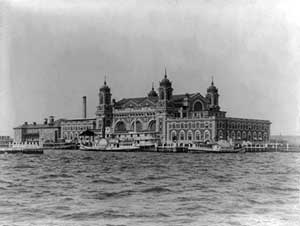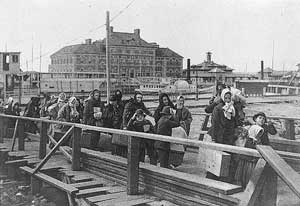文化面面觀 通向美國(guó)的大門——紐約埃利斯島
考考你 小試牛刀
文化面面觀
通向美國(guó)的大門——紐約埃利斯島

|
| Ellis Island |
From 1892 to 1954, Ellis Island was a gateway for more than 12 million immigrants seeking access to the United States' way of life. Because of its historical significance and proximity to the statue, the site was declared part of the Statue of Liberty National Monument in 1965, but the land and its buildings remained in decay and disrepair. After a $1 million cleanup grant by the federal government for the bicentennial in 1976, $165 million was raised in private donations to restore the main building, including the huge Great Hall, which was opened as a museum for visitors in 1990.
The federal government established its first immigration center at the site in 1890, using ballast from incoming ships as landfill to double the island in size. In 1892, Annie Moore from Ireland, age 15, was the first immigrant recorded to come through Ellis Island proper (for a few years before this, immigrants were processed at Castle Garden, still considered part of the Ellis Island experience today). In 1897, the original wooden buildings burned to the ground. While some records were lost, none of the ship manifests were lost as they were stored elsewhere. The main building that exists today was opened in 1900, and 389,000 immigrants were processed through it in the first year alone. The record number in one day occurred in 1907, with 11,747. By 1917, Congress required all immigrants over age 16 be literate, and quotas began a few years later.
 |
| Immigrants arriving at Ellis Island |
An estimated forty percent, or over 100 million Americans, can trace their ancestry through at least one man, woman, or child who entered the country through Ellis Island. During the peak years, thousands of immigrants arrived each day. Each immigrant was checked for diseases, disabilities, and legal problems, and each name was recorded. In the confusion and with so many languages entering the country, many of the clerks wrote names based on English phonetic spellings or quick approximations, and many of these names have stayed with families to this day. People in steerage class on the crossing steam-ships were asked to board ferries that brought them to the Ellis Island facilities. There, they stood for hours in long lines reaching up the long stairs to the Great Hall, complete with children and all the belongings they had brought with them, awaiting inspection and passage through Ellis Island to the trains or boats that would take them to New York City or upstate New York, or on to other areas of the country. About two percent, or 250,000, did not pass the inspections and were turned around to go back to their countries of origin.
The open-door policy of immigration did not always exist at Ellis Island. In the 1920s, quotas were enacted; later, immigration processing was moved overseas. During World War II, the facility was used to house enemy aliens. Finally, the entryway was closed in 1954 and offered for sale as surplus government property, until the National Park Service took it over during the Johnson administration in 1965.
Today, thousands of visitors include a trip to Ellis Island with their visit to the Statue of Liberty. Ferries bring them to the hallowed island, much as they did years ago with their ancestors. A passenger database helps them locate their ancestors' records.
—Connie Ann Kirk (answers.com)
考考你
用今日所學(xué)將下面的句子譯成英語(yǔ)。
1. 她巴結(jié)他,他說(shuō)什么話她都同意。
2. 我最近太忙了,家里現(xiàn)在又臟又亂,一團(tuán)糟。
Hitch《全民情敵》精講之四 考考你 參考答案
1. 我自作主張把郵件寄到他夏天的地址了。
I took the liberty of forwarding the mail to his summer address.
2. 路遠(yuǎn)極了。
It's a hell of a long way.
3. 如果他來(lái)?yè)v亂,讓他走開(kāi)。
If he comes here bothering you, tell him to fuck off.
影片對(duì)白 Man, male egos. I don't know how you guys make it through the day with them.
點(diǎn)擊進(jìn)入:更多精彩電影回顧
(英語(yǔ)點(diǎn)津Annabel編輯)